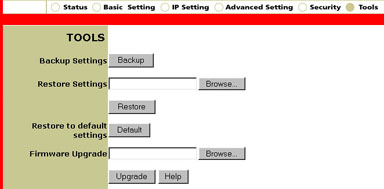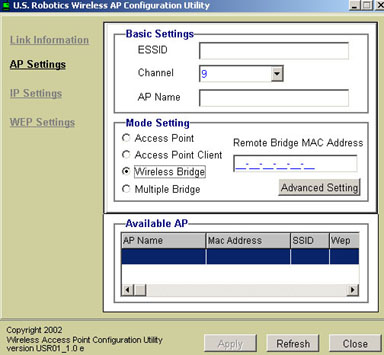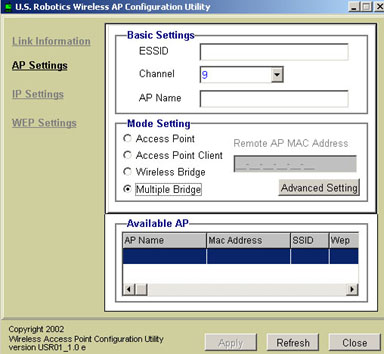
Contents:
About the 22 Mbps Wireless PC Card, PCI Adapter, and Access Point
Network Configuration and Planning
Adapter Installation and Configuration for Windows 98 SE/2000/Me/XP
22 Mbps Wireless Configuration Utilities
Product Specifications for 22 Mbps Wireless PC Card and PCI Adapter
Product Specifications for 22 Mbps Wireless Access Point
22 Mbps Wireless PC Card, PCI Adapter, and Access Point User Guide
22 Mbps Wireless Configuration Utilities
22 Mbps Wireless PC/PCI Network Configuration Utility
22 Mbps Wireless Access Point Configuration Utility
22 Mbps Wireless Access Point Web Configurator
22 Mbps Wireless PC/PCI Network Configuration Utility
The following section describes the various functions of the Network Configuration Utility. This utility provides quick access to all adapter settings. The configuration settings will be set by default to the correct values. Only advanced users should change any of the following settings.
After installation is complete, a Utility Tool icon will appear in the taskbar on the right side near the clock. Double-clicking the icon in the Quick Launch bar will open the Utility Tool main menu, providing quick access to all adapter settings. The Configuration Utility icon will be colored to indicate the status of your wireless network: red for disconnected, yellow for connected with poor quality, and green for connected with good quality.
![]()
![]()
![]()
There are five sections to the LAN Configuration Utility: Link Information, Configuration, Security, SiteSurvey, and About.
Link Information:
The Link Information section provides information about the current wireless network connection. You will see the status of the network, the SSID, the Tx Rate, and the Channel. There are two graph bars that represent the Link Quality and the Signal Strength. There are also two graphs that represent the Transmit and Receive Data Rates.

Configuration:
In the Configuration section you can change the network configuration information for the 22 Mbps Wireless PC Card or PCI Adapter.
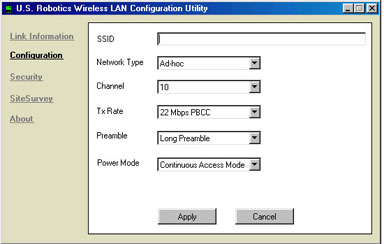
Description of Settings
The following are explanations of each adapter setting in the Configuration section.
SSID: SSID (Service Set Identifier) is the unique name that is shared among all 22 Mbps Wireless PC Cards or PCI Adapters and 22 Mbps Wireless Access Points in a wireless network. The SSID must be identical for all 22 Mbps Wireless PC Card or PCI Adapters and 22 Mbps Wireless Access Points participating in the same network. The SSID is case sensitive and must not exceed 30 characters.
Network Type:
- AdHoc: This mode is used for a simple peer-to-peer network. This type of network only allows the sharing of local resources between wireless clients without a Wireless Access Point.
- Infrastructure: This mode allows a wireless LAN to be integrated into an existing wired network through a Wireless Access Point. Infrastructure type networks also permit roaming between Wireless Access Points while maintaining the connection to all network resources. Infrastructure mode provides additional features, such as WEP security, power saving, and extended range.
- Auto-Detect: This mode allows the 22 Mbps Wireless PC Card or PCI Adapter to scan for and connect to an existing wireless network or other wireless networking products in the area.
Channel: This setting specifies the default 802.11b channel used by the Wireless LAN to communicate. In an Infrastructure type network without an Access Point active on the default channel, clients will scan through all available channels searching for a network with a matching SSID.
- Changing the Channel: Changing the channel is only effective in AdHoc networks. Networks that are operating in Infrastructure mode automatically scan for a channel. The following table contains the operational channel frequency for several countries.
|
Regulatory Channel Frequency
|
|||||||
|
Channel
|
Frequency (MHz)
|
FCC
|
Canada
|
ETSI
|
France
|
Spain
|
Japan
|
|
1
|
2412
|
X
|
X
|
X
|
|
|
|
|
2
|
2417
|
X
|
X
|
X
|
|
|
|
|
3
|
2422
|
X
|
X
|
X
|
|
|
|
|
4
|
2427
|
X
|
X
|
X
|
|
|
|
|
5
|
2432
|
X
|
X
|
X
|
|
|
|
|
6
|
2437
|
X
|
X
|
X
|
|
|
|
|
7
|
2442
|
X
|
X
|
X
|
|
|
|
|
8
|
2447
|
X
|
X
|
X
|
|
|
|
|
9
|
2452
|
X
|
X
|
X
|
|
|
|
|
10
|
2457
|
X
|
X
|
X
|
X
|
X
|
|
|
11
|
2465
|
X
|
X
|
X
|
X
|
X
|
|
|
12
|
2467
|
|
|
X
|
|
X
|
|
|
13
|
2472
|
|
|
X
|
|
X
|
|
|
14
|
2484
|
|
|
|
|
|
X
|
Tx Rate: TX Rate (transmit rate) selects the allowable transfer rates of the 22 Mbps Wireless PC Cards or PCI Adapters. To optimize performance and range, the TX Rate should be set to Fully Automatic. This will automatically adjust the transfer speed for the best performance and longest range.
Note: The Wireless Access Point must support the TX rate setting. If the Wireless Access Point does not support the TX rate, undesired results may occur.
Preamble: The preamble can be set to either Long Preamble or Short Preamble. This setting only applies to Infrastructure mode and must match the preamble setting of the Wireless Access Point you are connecting to.
Power Mode: Power Mode enables or disables the power saving features of your wireless adapter. When enabled on a laptop, the power saving mode can reduce power consumption by the wireless PC card and extend the battery life of your laptop. This setting is only implemented in a network that is operating in Infrastructure mode.
- Changing the Power Mode: The Power Mode is set by default to Continuous Access Mode. To change the setting, select either Maximum Power Save or Fast Power Save from the drop-down list and click Apply.
Security:
Within this section, you can change the security settings of your 22 Mbps Wireless PC Card or PCI Adapter.
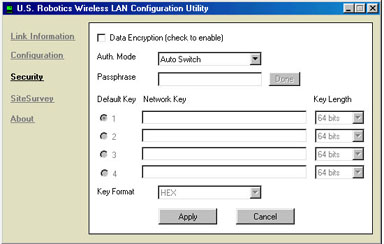
You can change the authentication mode by selecting the drop-down menu next to Auth. Mode. You can select from Auto Switch, Open Authentication, or Shared Authentication.
You can enable Data Encryption by selecting the checkbox at the top of the screen. If you select this, you will then need to enter a Passphrase. You will need to select either Hex or ASCII in the Key Format dropdown menu.
If you enable encryption, you will need to select and enter the WEP Network Keys from one to four, and you will need to select the Key Length from 64 bits, 128 bits, or 256 bits.
SiteSurvey:
Within this section, you can view the other networking products that you can connect to. There are two ways to connect with a wireless networking product in the list: either select a wireless networking product and click Connect or double-click a wireless networking product to automatically connect to it. Click Refresh to update the information that is shown.
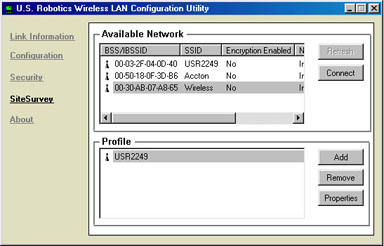
About:
Within this section you can view the version information for your 22 Mbps Wireless PC Card or PCI Adapter.
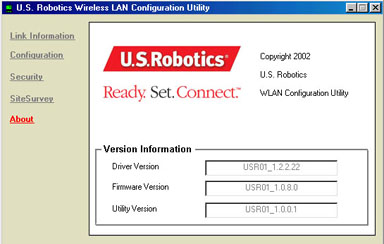
22 Mbps Wireless Access Point Configuration Utility
![]()
The Configuration Utility for the 22 Mbps Wireless Access Point has four sections: Link Information, AP Settings, IP Settings, and WEP Settings. If you make any changes to the configuration information within any of the four sections, you must click Apply in order for the changes to take effect. If the changes do not appear or if the information shown is not correct, click Refresh to update the information that is shown.
Link Information
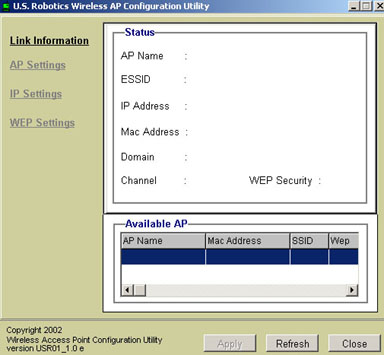
Within the Status area, you can view information about the AP Name, the ESSID, the IP Address, the Mac Address, the Domain, the Channel, and the WEP Security.
In the Available AP area, you can see a list of all the 22 Mbps Wireless Access Points that are detected.
AP Settings
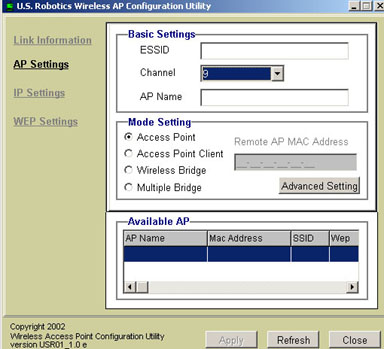
Within the AP Settings section, there are three areas: Basic Settings, Mode Setting, and Available AP.
In the Basic Settings area, you can enter an ESSID, select a channel, and assign a name to the 22 Mbps Wireless Access Point.
For Mode Setting, you can choose from the following:
- Access Point mode
- Access Point Client mode
- Wireless Bridge mode
- Multiple Bridge mode
Access Point mode
Access Point mode is used to connect up to 20 wireless clients. If you have up to 20 computers, each equipped with a wireless adapter, you can use Access Point mode to create a wireless network among the computers. This is the simplest configuration mode for the Wireless Access Point.
Access Point Client mode
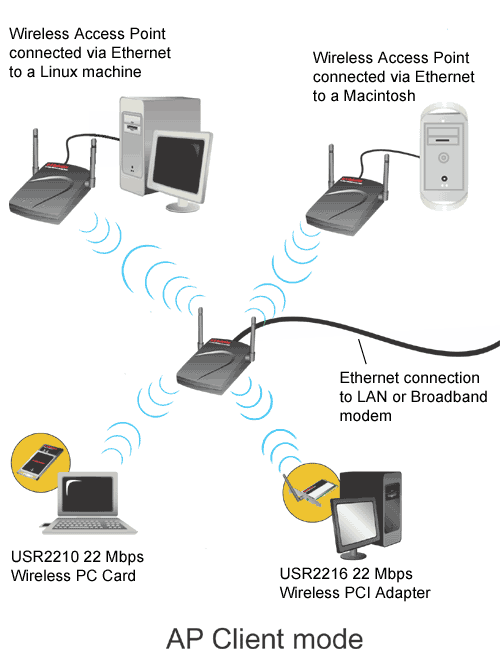
Access Point Client mode is used to connect any computers that don't support wireless adapters. By connecting a Wireless Access Point to each of these machines via Ethernet, the Wireless Access Point can be used as a wireless adapter. An example of this would be if you had four computers not all using the same operating platform, two of them running Windows 2000 with wireless adapters installed, one running Mac OS9, and one running Linux. If you connect a Wireless Access Point to the Macintosh computer, one to the Linux computer, and one for both Windows computers, you can wirelessly network each of these machines together by setting each Wireless Access Point to Access Point Client mode.
Note: If your Ethernet device or network adapter does not support auto-switching, you will need to use an Ethernet crossover cable to connect the Wireless Access Point in Access Point Client mode. Refer to the documentation for your Ethernet device or network adapter to see if it supports auto-switching.
Note: If you select Access Point Client mode, you will need to enter a Remote AP Mac Address.
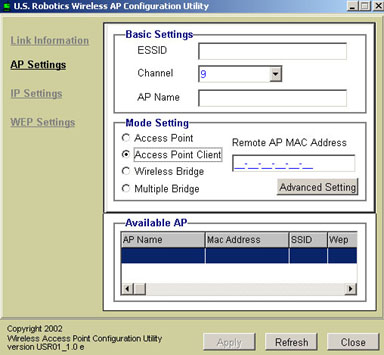
Wireless Bridge mode
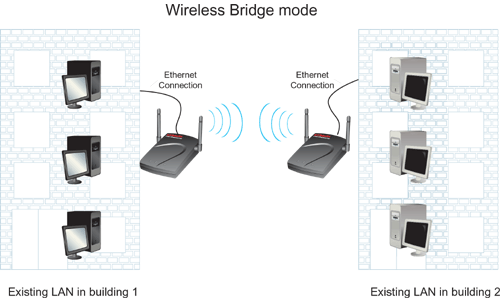
Wireless Bridge mode is used to wirelessly connect two existing wired Local Area Networks (LANs). By connecting a Wireless Access Point to each LAN and selecting Wireless Bridge mode, you can make the two Wireless Access Points talk only to each other, creating a secure connection between the different networks.
Note: If you select Wireless Bridge mode, you will need to enter a Remote Bridge Mac Address.
Multiple Bridge mode
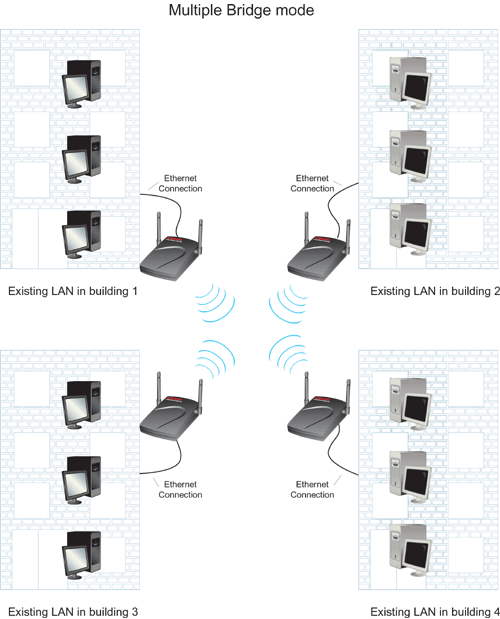
Multiple Bridge mode is similar to Wireless Bridge mode, but is used when you want to wirelessly connect more than two wired LANs. By connecting a Wireless Access Point to each LAN and selecting Multiple Bridge mode, you can make the Wireless Access Points talk only to each other, creating a secure connection between the different networks.
In the Mode Setting area there is also the Advanced Setting button. Here you will have eight options that you can enter information for: Transmission Rates, Preamble Type, SSID Broadcast, Beacon Interval, RTS Threshold, Fragmentation Threshold, DTIM Interval, and Antenna Selection.
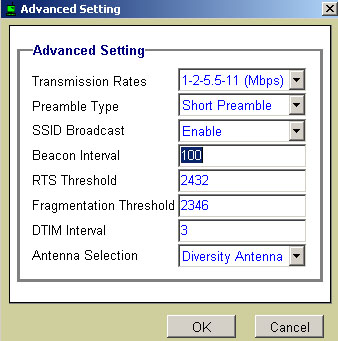
- For Transmission Rates, you can select 1-2 (Mbps), 1-2-5.5-11 (Mbps), or 1-2-5.5-11-22 (Mbps).
- In Preamble Type, you can select either Short Preamble or Long Preamble.
- In SSID Broadcast, you can select either Enable or Disable.
- For Beacon Interval, RTS Threshold, Fragmentation Threshold, and DTIM Interval, you will need to supply the appropriate information.
- In Antenna Selection, you can select either Left Antenna, Right Antenna, or Diversity Antenna.
When you are done selecting or entering any information, click OK to return to the main screen.
In the Available AP area, you can see a list of all the 22 Mbps Wireless Access Points that are detected.
IP Settings
In the IP Settings section, you can select either Fixed IP Address or DHCP Client.
If you select DHCP Client, this information will be retrieved automatically. The Configuration Utility is set to DHCP Client by default.
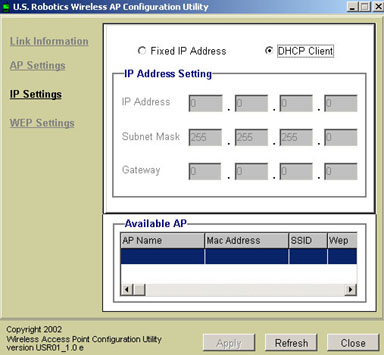
If you select Fixed IP Address, you will then need to enter the following information: an IP Address, a Subnet Mask, and a Gateway.
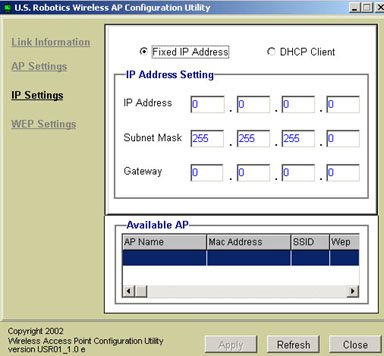
In the Available AP area, you can see a list of all the 22 Mbps Wireless Access Points that are detected.
WEP Settings
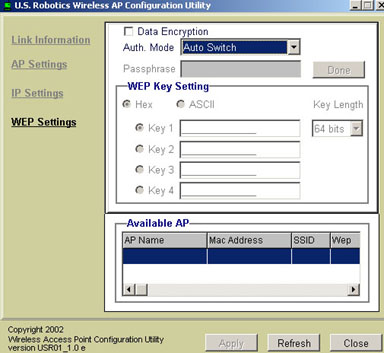
You can change the authentication mode by selecting the drop-down menu next to Auth. Mode. You can select from Auto Switch, Open Authentication, or Shared Authentication.
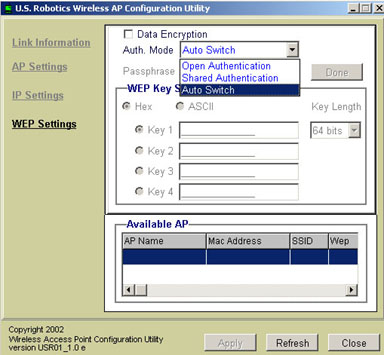
In the WEP Settings section, you can enable Data Encryption by selecting the checkbox at the top of the screen. If you select this, you will then need to enter a Passphrase. You will also need to select either Hex or ASCII in the WEP Key Setting window.
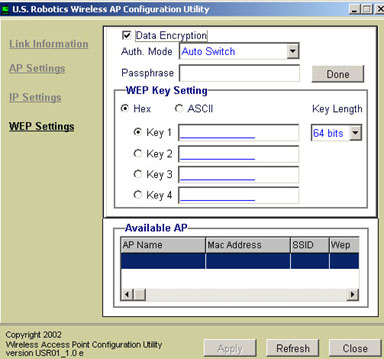
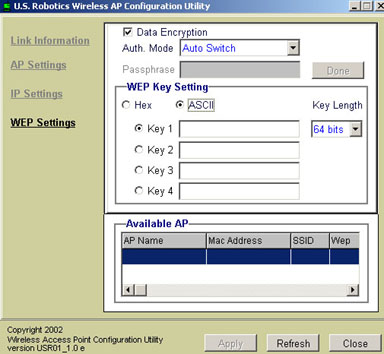
You will also need to select and enter the WEP Keys from one to four, and you will need to select the Key Length from 64 bits, 128 bits, or 256 bits.
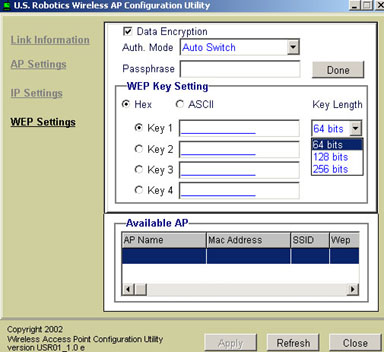
In the Available AP area, you can see a list of all the 22 Mbps Wireless Access Points that are detected.
22 Mbps Wireless Access Point Web Configurator
After launching the 22 Mbps Wireless Access Point Configuration Utility, note the IP address of the 22 Mbps Wireless Access Point. Launch a Web browser and enter that IP address. This will launch the Web Configurator of the 22 Mbps Wireless Access Point.
There are six sections to the Web Configurator: Status, Basic Setting, IP Setting, Advanced Setting, Security, and Tools. Every time you make a change to the configuration settings of the 22 Mbps Wireless Access Point, you must click Apply for the changes to take effect.
Status
Within Status, you can view the current network information for the 22 Mbps Wireless Access Point.
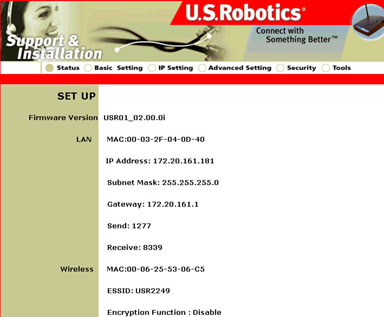
Basic Setting
In this section you can assign a name to the 22 Mbps Wireless Access Point, enter a WLAN ESSID, and select a channel. You can choose a setting for the WEP key: Disable, 64bits, 128bits, or 256bits. You will need to select either Hex or ASCII in the Mode drop-down menu and enter the WEP Keys.
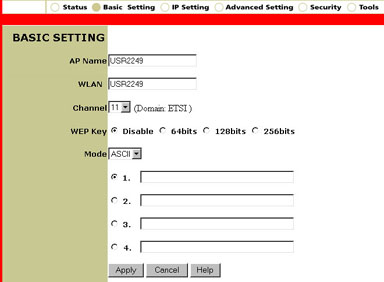
IP Setting
In the IP Setting section you can select either Obtain Automatically or Fixed IP for the LAN IP. If you select Fixed IP, you will need to enter the Address, the Subnet Mask, and the Gateway. You can turn or off the DHCP Server in this area. If you turn DHCP Server on, you will need to enter an IP Range and a DNS Server.
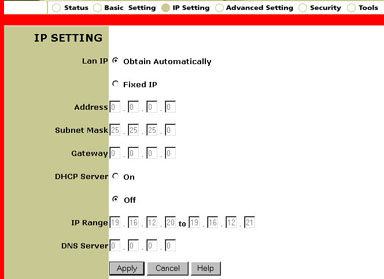
Advanced Setting
Only advanced users should change any of the configuration settings in this section.
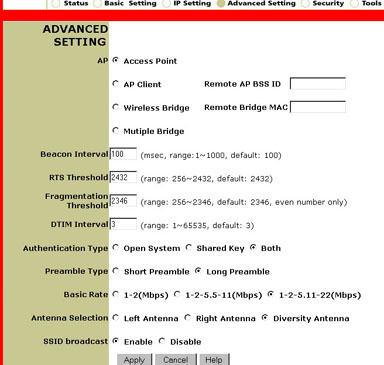
For AP mode, you can choose from the following:
- Access Point mode
- Access Point Client mode
- Wireless Bridge mode
- Multiple Bridge mode
Access Point mode
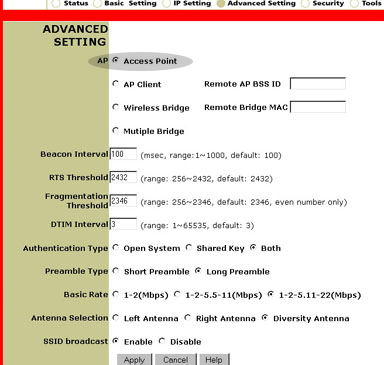
Access Point mode is used to connect up to 20 wireless clients. If you have up to 20 computers, each equipped with a wireless adapter, you can use Access Point mode to create a wireless network between the computers. This is the simplest configuration mode for the Wireless Access Point.
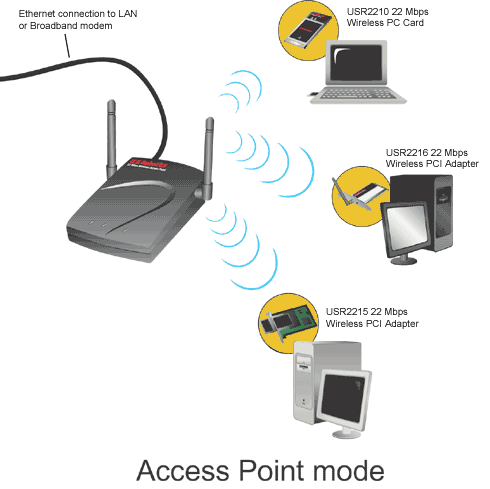
Access Point Client mode
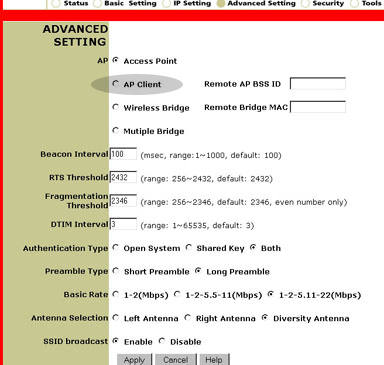
Access Point Client mode is used to connect any computers that don't support wireless adapters. By connecting a Wireless Access Point to each of these machines via ethernet, the Wireless Access Point can be used as a wireless adapter. An example of this would be if you had four computers not all using the same operating platform: two of them running Windows 2000 with wireless adapters installed, one running Mac OS9, and one running Linux. If you connect a Wireless Access Point to the Mac computer, one to the Linux computer, and one for both Windows computers, and then set each Wireless Access Point to Access Point Client mode, you could wirelessly network each of these machines together.
Note: If your Ethernet device or network adapter does not support auto-switching, you will need to use an Ethernet crossover cable to connect the Wireless Access Point in Access Point Client mode. Refer to the documentation for your Ethernet device or network adapter to see if it supports auto-switching.
Note: If you select Access Point Client mode, you will need to enter a Remote AP Mac Address.

Wireless Bridge mode
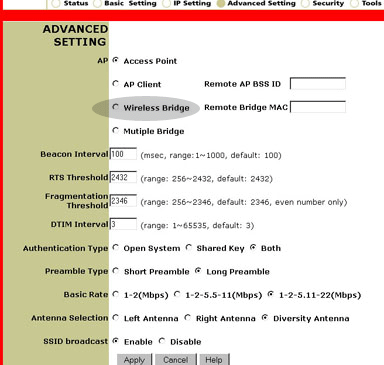
Wireless Bridge mode is used to wirelessly connect two existing wired Local Area Networks (LANs). By connecting a Wireless Access Point to each LAN and selecting Wireless Bridge mode, the two Wireless Access Points will talk only with each other, creating a secure connection between the different networks.
Note: If you select Wireless Bridge mode, you will need to enter a Remote Bridge Mac Address.

Multiple Bridge mode
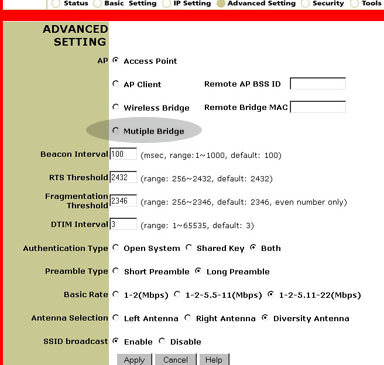
Multiple Bridge mode is similar to Wireless Bridge mode, but is used when you want to wirelessly connect more than two wired LANs. By connecting a Wireless Access Point to each LAN and selecting Multiple Bridge mode, the multiple Wireless Access Points will talk only with each other, creating a secure connection between the different networks.

For Beacon Interval, RTS Threshold, Fragmentation Threshold, and DTIM Interval, you will need to supply the appropriate information.
For Transmission Rates, you can select 1-2 (Mbps), 1-2-5.5-11 (Mbps), or 1-2-5.5-11-22 (Mbps).
In Authentication Type, you can select Open System, Shared Key, or Both.
In Preamble Type, you can select Short Preamble or Long Preamble.
In Basic Rate, you can select 1-2 (Mbps), 1-2-5.5-11 (Mbps), or 1-2-5.5-11-22 (Mbps).
In Antenna Selection, you can select Left Antenna, Right Antenna, or Diversity Antenna.
In SSID Broadcast, you can select either Enable or Disable.
Security
Within the Security section, you can change the security information for the 22 Mbps Wireless Access Point.
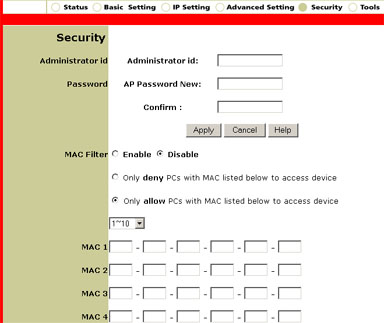
You can enter an Administrator ID and a Password. If you create these, you must click Apply for the settings to take effect.
You can select either Enable or Disable for the MAC filter. If you enable the MAC filter, you can enter the MAC addresses of computers that you do not want to connect with the 22 Mbps Wireless Access Point.
Tools
Within the Tools section, you can save the settings of your 22 Mbps Wireless Access Point by clicking Backup. If you change your settings and want to retrieve your saved settings, you can click Browse to locate the saved file. Once you locate the saved file, click Restore.
If you want to restore the default settings of the 22 Mbps Wireless Access Point, click Default
If a new firmware version is made available and you have downloaded it, click Browse next to Firmware Upgrade to locate the correct version file. When you have located it, click Upgrade to implement the new firmware.
